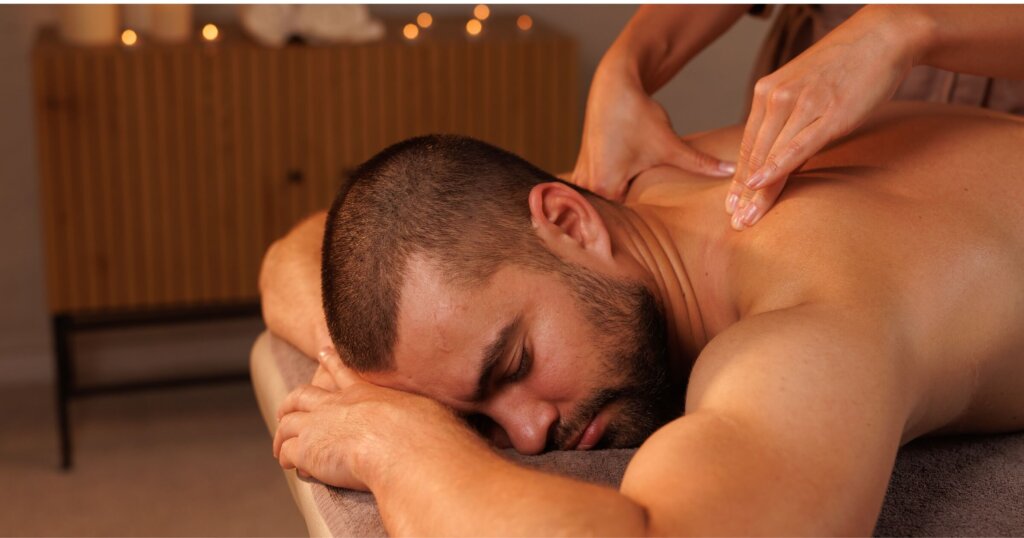Sore knees, tight shoulders, and constant backaches are part of the job for many people in the trades. When your work demands long hours of lifting, bending, and repetitive motion, it can take a serious toll on your body and mind. That’s where massage therapy comes in. While many think of massage therapy as a luxury, the truth is that it’s a smart, practical way to manage pain and prevent injury. In this article, we’re going to cover the benefits of massage for people dealing with tight muscles and body aches and why they should make it a part of their health routine.
Quick look:
- Massage is important for self-care for workers in physically demanding trades, helping to relieve chronic pain and prevent injury.
- Repetitive motion, heavy lifting, and vibration from tools can cause long-term strain on joints and muscles. Massage counters these impacts by improving circulation and flexibility.
- Mental health benefits include stress reduction, better sleep, and a clearer mindset, which help manage the pressures of construction work.
- Regular massage can help workers who depend on their bodies daily detect early signs of injury, support recovery, and boost long-term physical resilience.
Common physical strains workers face
Hours of repetitive movement
Physically demanding and repetitive work is taxing on the body. The same motions day after day, whether swinging a hammer, kneeling to install flooring, or constantly reaching overhead, can wear down your body over time. The shoulders, knees, and lower back take the brunt, which can lead to chronic soreness and stiff muscles.

Image sourced from Shutterstock
This kind of strain increases your risk of overuse injuries like tendonitis, carpal tunnel syndrome, and other soft tissue issues that can sideline you from work. Without regular care or recovery, what starts as a dull ache can turn into a long-term problem. Paying attention to early signs of lower back pain and incorporating recovery tools like massage can go a long way in keeping your body in working shape.
Heavy lifting and awkward postures
From hoisting materials to working in tight spaces, construction demands a lot from your muscles and joints. Constant lifting, especially without proper support or rest, leads to muscle fatigue and microscopic tears that add up over time. It’s the kind of wear and tear you might not notice immediately, but your body feels it by the end of the day.
If you add awkward postures like twisting while carrying, crouching in low spots, or reaching above your head, you’re putting extra pressure on your spine, knees, and shoulders. These movements can compress joints, tighten soft tissue over time, and increase the chance of injury. Taking steps to protect your joints, especially your knees, is important for workers already facing unique challenges on the job site.
Vibration from tools and machinery
Power tools are a basic necessity on most job sites, but the constant vibration they produce can quietly do damage over time. Jackhammers, drills, grinders, and other heavy equipment send steady pulses through your hands, arms, and shoulders, and prolonged exposure can lead to serious issues like nerve damage, poor circulation, and tingling or numbness in the extremities.
Even if you don’t feel it right away, repeated vibration increases overall muscle tension and stiffness, making it harder for your body to relax and recover after a long day. Over time, this added stress can affect everything from your grip strength to your posture, making preventative care, like massage, an important part of staying healthy in the trades.
How massage therapy helps construction workers
Improves blood flow and speeds up recovery
One of the biggest benefits of massage for construction workers is improved circulation. When muscles are tight or overworked, blood flow can become restricted, making it harder for the body to deliver oxygen and nutrients where they’re needed most. Massage helps open things back up, encouraging healthy blood flow to fatigued muscles and speeding up the natural healing process.
That boost in circulation also helps flush out metabolic waste, which means less soreness after a long day and quicker recovery between shifts. Combined with other smart recovery habits like hydration, sleep, and reducing inflammation, regular massage can help you feel stronger, looser, and more ready for whatever the job throws at you.
Relieves muscle tension and pain
Tight muscles can limit your range of motion, throw off your posture, and increase your risk of injury. Massage therapy works to release those tight spots, helping restore mobility and bring your body back into better alignment.
Massage can provide targeted relief for construction workers dealing with chronic overuse, like shoulder stiffness from overhead work or lower back pain from constant bending. Easing deep muscle tension helps reduce pain and makes everyday movements feel smoother and less strained.

Image sourced from Shutterstock
Identifies tight spots before they become injuries
One of the most underrated benefits of massage is early detection. A skilled massage therapist can often feel areas of tension or imbalance in your muscles before you even notice something’s off. These subtle signs, such as tightness, reduced mobility, or tenderness, can be early warnings that your body is compensating for overuse or strain.
Catching these issues early allows you to address them before they become bigger problems, like sprains, strains, or work-stopping injuries. For tradespeople who rely on staying physically ready every day, that kind of proactive care can make all the difference.
Long-term injury prevention
Massage isn’t just about feeling better in the moment; it’s an investment in your long-term health. Regular sessions help maintain joint mobility and keep soft tissues like muscles, tendons, and fascia flexible and resilient. That upkeep is important when your body takes a daily beating on the job site.
By reducing built-up tension and improving overall tissue health, massage lowers your risk of developing chronic issues like tendonitis, muscle strains, or other musculoskeletal disorders that can sideline you long-term. When combined with proper form, rest, and supportive gear, massage becomes a powerful tool for staying strong, mobile, and injury-free for the long haul.
Mental health benefits of massage
Reduces stress and anxiety
Construction work is also mentally draining. Stress levels can run high between tight deadlines, unpredictable weather, and job site hazards. Massage helps calm the body’s stress response by activating the parasympathetic nervous system, the part responsible for rest and recovery. As your body relaxes, stress hormone levels like cortisol start to drop, helping you feel more at ease both on and off the clock.
Improves sleep and mood
When your body is constantly in go mode, it’s tough to wind down at night. Massage therapy encourages the release of feel-good chemicals like serotonin and dopamine, which can help regulate mood and improve sleep quality. Better sleep boosts energy and plays a major role in preventing burnout and supporting overall mental health. That’s especially important in an industry where mental health challenges are all too common.
Supports mindfulness and mental reset
Taking time to slow down is often overlooked in construction. Massage provides a rare opportunity to unplug, breathe, and reconnect with your body. This kind of mindful reset encourages mental clarity and emotional regulation, giving workers the space to recover physically and mentally. It’s a small break with a big impact.
Bottom line
Massage is a smart, proactive form of self-care for anyone working in the trades. It can help workers both in their physical and mental well-being, from easing everyday aches to helping them focus on the job. Making it a part of your monthly routine will help maximize the benefits of massage but you can go even more frequently to increase the results.
For more practical tips for staying strong and healthy in the trades, subscribe to our newsletter for weekly insights, expert advice, and field-tested wellness strategies built for workers like you.


